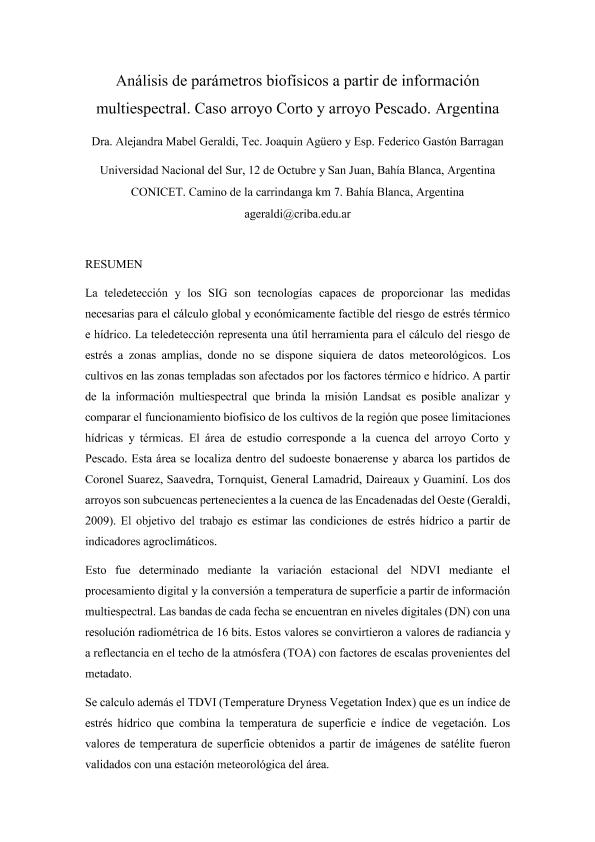Artículo
La teledetección y los SIG son tecnologías capaces de proporcionar las medidas necesarias para el cálculo global y económicamente factible del riesgo de estrés térmico e hídrico. La teledetección representa una útil herramienta para el cálculo del riesgo de estrés a zonas amplias, donde no se dispone siquiera de datos meteorológicos. Los cultivos en las zonas templadas son afectados por los factores térmico e hídrico. A partir de la información multiespectral que brinda la misión Landsat es posible analizar y comparar el funcionamiento biofísico de los cultivos de la región que posee limitaciones hídricas y térmicas. El área de estudio corresponde a la cuenca del arroyo Corto y Pescado. Esta área se localiza dentro del sudoeste bonaerense y abarca los partidos de Coronel Suarez, Saavedra, Tornquist, General Lamadrid, Daireaux y Guaminí. Los dos arroyos son subcuencas pertenecientes a la cuenca de las Encadenadas del Oeste (Geraldi, 2009). El objetivo del trabajo es estimar las condiciones de estrés hídrico a partir de indicadores agroclimáticos. Esto fue determinado mediante la variación estacional del NDVI mediante el procesamiento digital y la conversión a temperatura de superficie a partir de información multiespectral. Las bandas de cada fecha se encuentran en niveles digitales (DN) con una resolución radiométrica de 16 bits. Estos valores se convirtieron a valores de radiancia y a reflectancia en el techo de la atmósfera (TOA) con factores de escalas provenientes del metadato.Se calculo además el TDVI (Temperature Dryness Vegetation Index) que es un índice de estrés hídrico que combina la temperatura de superficie e índice de vegetación. Los valores de temperatura de superficie obtenidos a partir de imágenes de satélite fueron validados con una estación meteorológica del área. Se obtuvo que de acuerdo al TDVI la cuenca presenta un déficit alto en las cuatro estaciones, sobre todo en el otoño, invierno y primavera. El sector central del área de estudio presenta una leve mejora en cuanto al déficit en la primavera. Existe un déficit alto y moderado en la gran mayoría de los cultivos, a pesar que las precipitaciones fueron mayores al promedio anual (1141 mm). El TDVI sirve como otra herramienta de análisis adicional a las ya más conocidas como el NDVI. Además, esta herramienta incorpora la variante de la temperatura logrando un estudio más amplio del mismo. Una gran utilidad del mismo puede ser la de determinar nuevas áreas de riego o relocalizar las áreas ya regadas. The remote sensing and the GIS are technology that are capable of providing the necessary measures for the global and economically feasible calculation of the risk of thermal and water stress. The remote sensing represents a useful tool for calculating the risk of stress to large areas, where meteorological data aren’t available. The crops in temperate zones are affected by thermal and water factors. Based on the multispectral information provided by the Landsat 8, it allows us to analyze and compare the biophysical behavior of the crops in the region that has water and thermal limitations. The basin of the Corto y Pescado stream are de study area. This area is located in southwestern Buenos Aires and includes the administrative divisions of Coronel Suarez, Saavedra, Tornquist, General Lamadrid, Daireaux and Guaminí. The two streams are subbasins belonging to the Encadenadas del Oeste basin. The main objective was to estimate water stress conditions from agroclimatic indicators. This was determined by seasonal variation of NDVI through digital processing and conversion to surface temperature from multispectral information. These calculations allow us to calculate the TDVI (Temperature Dryness Vegetation Index), which is an index of water stress that combines the surface temperature and a vegetation index. The surface temperature values obtained from satellite images were validated with a weather station in the area. The calculation of the index was made for January 15, April 21, July 26 and November 15 from 2014. The date bands are in digital levels (DN) with a radiometric resolution of 16 bits. These values were converted to radiance and reflectance values in the roof of the atmosphere (TOA) with scale factors from the metadata. It was obtained that according to the index the basin presents a high deficit in the four seasons, especially in the autumn, winter and spring. The study area central sector shows a slight improvement regarding the deficit in the spring. There is a high and moderate deficit in the crops majority, although rainfall was higher than the annual average (1141 mm). The TDVI serves as another additional analysis tool to those already known as the NDVI. In addition, this tool incorporates the temperature variant achieving a wider study of it. A great use of it can be to determine irrigation new areas or relocate areas already irrigated.
Análisis de parámetros biofísicos a partir de información multiespectral. Caso arroyo Corto y arroyo Pescado. Argentina
Fecha de publicación:
03/2019
Editorial:
Universidad Distrital Francisco José de Caldas
Revista:
Azimut
ISSN:
2346-1055
Idioma:
Español
Tipo de recurso:
Artículo publicado
Clasificación temática:
Resumen
Palabras clave:
PARÁMETROS BIOFÍSICOS
,
TELEDETECCIÓN
,
LANDSAT 8
,
TVDI
,
CUENCA
Archivos asociados
Licencia
Identificadores
Colecciones
Articulos(IADO)
Articulos de INST.ARG.DE OCEANOGRAFIA (I)
Articulos de INST.ARG.DE OCEANOGRAFIA (I)
Citación
Geraldi, Alejandra Mabel; Aguero, Joaquin; Barragan, Federico; Análisis de parámetros biofísicos a partir de información multiespectral. Caso arroyo Corto y arroyo Pescado. Argentina; Universidad Distrital Francisco José de Caldas; Azimut; 10; 1; 3-2019; 10-20
Compartir




